Harrymag Ventures LTD is the ideal place you can get every equipment you need to start a bakery in Nigeria. The Nigerian bakery industry is a dynamic and booming sector driven by the country’s increasing need for baked goods. Nigerians consume a lot of bread, pastries, and confections; therefore, bakeries are important in both urban and rural locations. Rapid population increase, shifting lifestyles, and consumer preferences for quick and inexpensive baked goods are major drivers of the industry’s expansion.

Local bakeries frequently accommodate a wide range of palates by fusing classic flavors and traditions with cutting-edge creations. While bread is still a staple, gourmet cakes, pastries, and snacks are becoming more and more popular. The market offers entrepreneurs the chance to open huge production facilities or small bakeries, which will help to create jobs and boost the economy.
Changing costs for raw materials, limitations on infrastructure, and the requirement to maintain hygienic and quality standards are some of the industry’s challenges. Notwithstanding these obstacles, Nigeria’s bakery industry is still developing, which is indicative of the nation’s changing customer preferences and entrepreneurial spirit.
Importance Of Having The Right Bakery Equipment
Having the right bakery equipment is crucial for several reasons:

Efficiency: Baking procedures are streamlined with appropriate equipment, which saves time and work. Higher production rates are made possible by this efficiency, which also guarantees on-time delivery to satisfy client requests.
Consistency in Quality: Having the appropriate tools aids in preserving baked items’ constant quality. To ensure that every product satisfies the required requirements, uniformity is facilitated by precise measurements and controlled processes.
Product Variety: A wide variety of baked goods can be produced with the right equipment. With the correct equipment, a bakery can increase the variety of products it offers and satisfy a wide range of client preferences, from bread and pastries to cakes and cookies.
Cost-effectiveness: Although purchasing high-quality equipment may appear pricey at first, doing so will pay you in the long run. Durable, energy-efficient machinery lowers operating expenses and lowers the need for regular maintenance or replacements.
Safety and hygienic: In the food sector, good hygienic measures are crucial, and they are supported by the appropriate equipment. The right bakery equipment helps maintain a clean and safe working environment, satisfying health and safety standards, with features like temperature control and easily clean surfaces.
Customer happiness is influenced by consistency, diversity, and quality. In the cutthroat baking industry, meeting or beyond client expectations fosters loyalty and favorable word-of-mouth.
In conclusion, the impact that the proper bakery equipment has on cost-effectiveness, efficiency, quality, variety, safety, and hygiene—not to mention customer satisfaction—makes it crucial.
Essential Baking Equipment
1. Ovens
Convection Oven: Industrial-grade convection ovens featuring strong fans to provide uniform heat distribution.

Benefits include faster baking times, consistency in products, and suitability for large-scale production.
Deck Ovens:
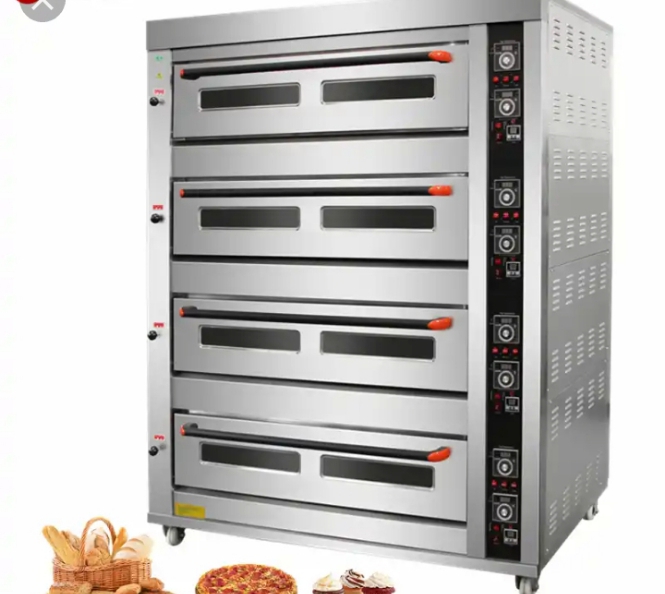
Industrial deck ovens have many decks that are made for baking in large quantities.
Benefits: Adaptable, adjustable temperature zones, perfect for artisan bread and other pastries.
Rotary Ovens:
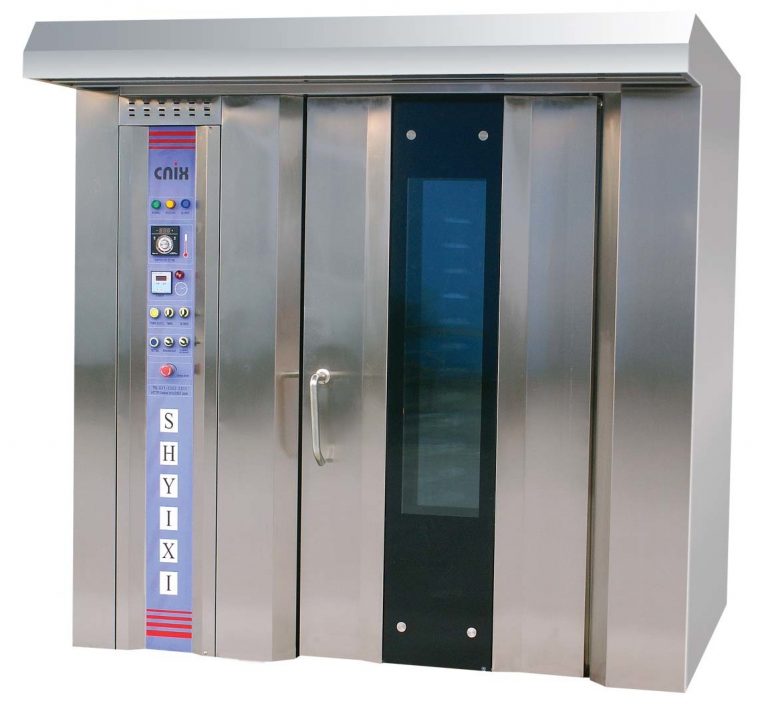
Huge rotary ovens equipped with revolving racks for effective and consistent baking.
Benefits include a high production capacity, consistency in outcomes, and suitability for continuous operation.
Rack Oven:

Industrial rack ovens designed to bake numerous items at once using multiple racks.
Benefits: Compact in size, appropriate for baking in batches, and perfect for large-scale manufacturing.
Tunnel Oven:
Ovens on a continuous conveyor belt that are intended for industrial mass production.
Benefits: Effective for large-scale baking, reliable outcomes, and high production capacity.
Multi Deck Oven:
Ovens using numerous stacked decks to enhance baking capacity.
Benefits: Versatile, effective in utilizing space, and appropriate for a range of baked products.
Hybrid Ovens:
Combining elements of several oven types to provide versatility for a range of baking requirements.
Benefits: Adaptability to various product kinds, appropriate for a range of commercial baking activities.
Cyclothermic Ovens:
Described as: Cycle-based heat distribution ovens that let you regulate the baking temperature.
Benefits: Accurate temperature control, ideal for specialty and artisanal baked items.
Revolving tray ovens:
Ovens featuring rotating trays or trolleys that facilitate effective product loading and unloading.
Benefits: Easy to use, consistent baking, and suitable for large-scale production.
A bakery should consider various criteria, including production capacity, available space, and the particular items to be baked, while choosing an industrial oven. varied industrial oven types have varied features to meet various operational needs.
2. Mixers
Spiral Mixers
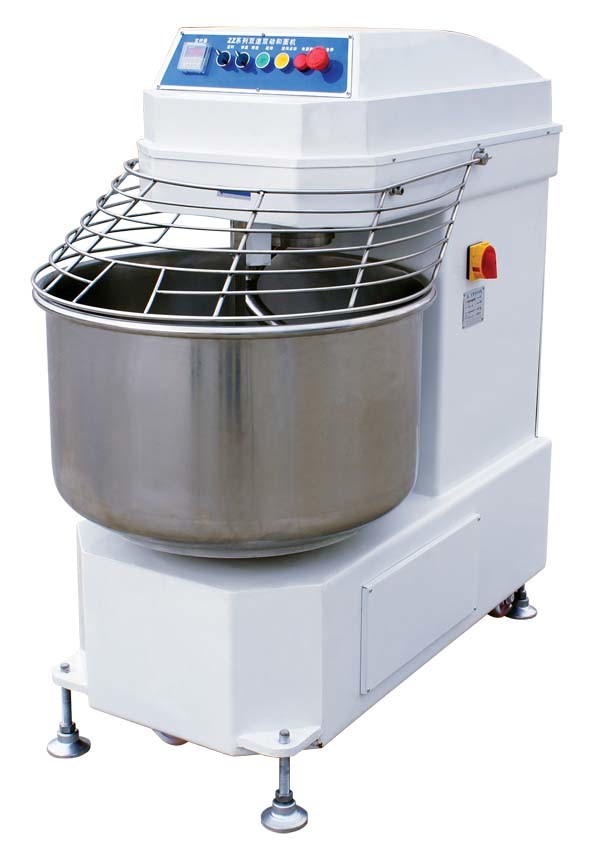
Perfect for combining big amounts of dough, particularly for pizza and bread. Their agitator is fashioned like a spiral and simulates hand kneading.
Important: Prevents dough overheating, guarantees complete and uniform mixing, and is appropriate for dough with a high hydration level.
Planetary Mixers: Described as adaptable mixers featuring a beater that rotates on an offset shaft and a spinning, non-removable bowl.
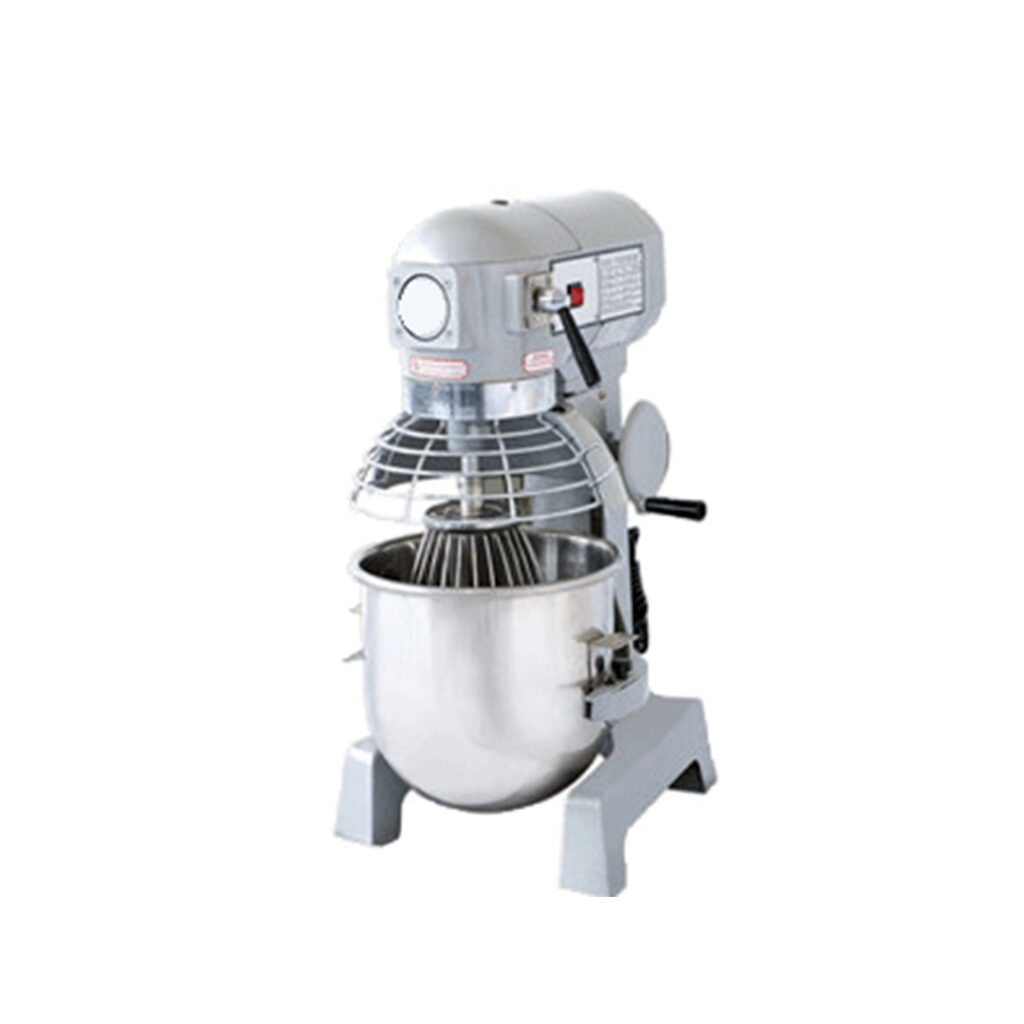
Relevance: They are necessary for cake batters, creams, and other pastry recipes since they can be used for a variety of functions, including whipping, beating, and combining.
Horizontal Mixers:
Large-scale mixers used in industrial bakeries that are made for high-volume output.
The ability to mix large batches of dough effectively is crucial for maintaining uniformity in quality and fulfilling the needs of mass production.
Double-Arm Mixers: Described as robust mixers with two independently rotating mixing arms.
Significance: Fit for firm dough and vigorous mixing, guaranteeing complete blending of components for goods such as bagels and pretzels.
Vertical Cutter Mixers: Suitable for pastry dough and fillings, these devices combine cutting and mixing capabilities within a vertical chamber.
Important: This combines ingredients quickly and precisely, enabling for a wide range of baked items to be made with them.
High-Speed Mixers: Described as mixers made for quick mixing, they are frequently employed for certain jobs that call for quick mixing periods.
Significance: Enhances manufacturing effectiveness and appropriate for specific dough varieties requiring less mixing time.
Dough Dividers and Rounders: Despite not being conventional mixers, these devices are essential for dividing and rounding dough, which guarantees consistency. Importance: Reduces labor and time required, ensures uniform serving sizes, and enhances baking process efficiency overall.
Continuous Mixers: Suitable for large-scale, continuous production, these mixers are designed to allow ingredients to flow continuously.
Significance: Guarantees a consistent flow of blended dough, diminishing idle time and enhancing overall manufacturing effectiveness.
The amount of production, the kinds of products being produced, and the particular needs of the recipes all play a role in selecting the appropriate mixers for a bakery. Every kind of mixer has a distinct function during baking, which enhances the effectiveness and caliber of the bakery industry.
3. Dough Proofer
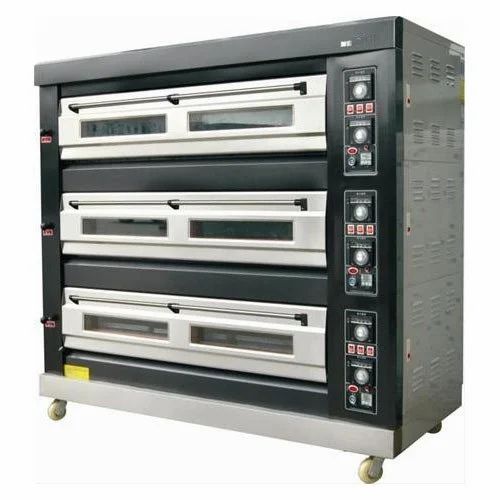
The significance of optimal dough fermentation The proofer allows the dough to ferment at its best rate because it creates a regulated environment with constant humidity and temperature. This enhances the finished baked goods’ flavor, texture, and general excellence.
Significance: Guarantees uniform dough rising, averting variations in product dimensions and consistency. This is especially important for products that need to be uniform, like bread.
Time Management:
Significance: Accelerates the fermentation process, allowing bakers to sustain productive timetables. It contributes to a reduction in the total production time, enabling greater output.
Consistency of Batch:
Significance: Facilitates uniform outcomes among batches. The proofer’s controlled environment aids in preserving the fermentation process’ homogeneity, which results in consistently high-quality products.
Adaptability:
Importance: A flexible equipment in a bakery, it may be used with different kinds of dough and recipes. A dough proofer works with several sorts of dough, whether it’s for bread, rolls, or pastries.
Selecting The Appropriate Sizes And Features
Control of Humidity and Temperature:
Important: Verify that the proofer provides accurate humidity and temperature control. For the best possible fermentation, different kinds of dough require different circumstances.
Modifiable Shelves or Racks: Significance enables for the flexible accommodation of various dough kinds and batch sizes. Racks with movable sections help make effective use of available space.
Appropriate Air Venting
Importantly, adequate ventilation keeps too much moisture from accumulating, guaranteeing that the dough rises regularly without getting overly moist or sticky.
Digital Monitoring and Controls:
Relevance: Accurate temperature and humidity settings and maintenance are made possible by digital controllers. Bakers can monitor the fermentation process with the use of monitoring features.
Energy Effectiveness:
Relevance: Select a proofer that has energy-saving features to save money on maintenance. Large-scale industrial bakeries, where energy usage can be significant, should pay particular attention to this.
Dimensions and Absorbency:
Relevance: Choose a proofer size based on the amount of work that the bakery can produce. Think about how many shelves or racks the bakery will need to hold the usual batch sizes.
Cleaning Ease: Relevance: Select a proofer that has parts that are clean and easily accessible. Maintaining cleanliness is essential when baking, and an easily cleaned proofer adds to a hygienic baking atmosphere.
Selecting the ideal size and features guarantees that the industrial dough proofer will efficiently meet the production demands of the bakery, producing consistently excellent baked items.
4. Baking Pans And Trays

Sheet Pans:
Description: Flat, rectangular pans with raised edges. Commonly used for cookies, pastries, and sheet cakes.
Round Cake Pans:
Description: Circular pans used for baking layer cakes. Available in various sizes to accommodate different cake recipes.
Loaf Pans:
Description: Rectangular pans with higher sides, suitable for baking bread loaves.
Muffin Tins:
Description: Pan with multiple round depressions, used for baking muffins and cupcakes.
Bundt Pans:
Description: Decorative, fluted pans used for baking Bundt cakes. They often have a central tube for even baking.
Pie Pans:
Description: Round, shallow pans with sloping sides, ideal for baking pies and tarts.
Springform Pans:
Description: Round pans with a removable bottom and an adjustable latch on the sides. Suitable for delicate items like cheesecakes.
Cupcake Liners:
Description: Paper or foil liners used inside muffin tins for easy removal of cupcakes.
Material Considerations And Maintenance
Aluminum Pans:
Material Consideration: Heats quickly and evenly. Lightweight and cost-effective.
Maintenance: Hand wash with mild soap and avoid using abrasive pads to prevent scratching. Dry thoroughly to prevent corrosion.
Non-Stick Pans:
Material Consideration: Coated with a non-stick surface for easy release of baked goods.
Maintenance: Avoid using metal utensils that can damage the coating. Hand wash with a soft sponge to preserve the non-stick properties.
Stainless Steel Pans:
Material Consideration: Durable and resistant to corrosion. Heavier than aluminum.
Maintenance: Dishwasher safe, but hand washing with a non-abrasive cleaner is recommended for longevity.
Silicone Baking Mats:
Material Consideration: Flexible and non-stick, promoting even baking.
Maintenance: Wipe clean or hand wash. Avoid using sharp utensils to prevent damage.
Glass Baking Dishes:
Material Consideration: Offers even heat distribution. Can go from the oven to the table.
Maintenance: Handle with care to avoid breakage. Dishwasher safe for convenience.
Copper Pans:
Material Consideration: Retains and distributes heat well. Suitable for certain types of baking.
Maintenance: Season regularly to maintain non-stick properties. Hand wash and dry promptly to prevent rust.
Understanding the material considerations and following proper maintenance practices ensures the longevity and effectiveness of baking pans and trays in a bakery.
Additional Equipment For a Well-Equipped Bakery
Dough Divider and Rounder
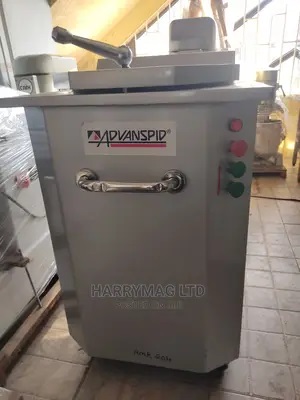
Factors to consider when selecting a divider and rounder.
A dough divider is a crucial piece of equipment in a bakery, responsible for dividing large batches of dough into equal portions. Here are factors to consider when selecting a dough divider for a bakery business:
Capacity:
Consideration: The amount of dough the machine can handle per cycle.
Importance: Choose a divider with a capacity that aligns with your bakery’s production needs.
Type of Dough:
Consideration: Some dividers are designed for specific types of dough, such as soft or stiff.
Importance: Ensure the divider is suitable for the types of dough you commonly work with to achieve optimal performance.
Adjustability:
Consideration: The ability to adjust the size of the dough portions.
Importance: Flexibility in portion sizes is essential for producing various baked goods.
Consistency:
Consideration: The machine’s ability to consistently divide dough into equal portions.
Importance: Consistency in portion size is crucial for uniformity in the final baked products.
Ease of Cleaning:
Consideration: The design of the machine and accessibility for cleaning.
Importance: Easy cleaning contributes to maintaining hygiene in the bakery.
Durability:
Consideration: The build quality and materials used in the construction of the divider.Importance: A durable machine ensures a longer lifespan and reduces the need for frequent replacements.
Importance: A durable machine ensures a longer lifespan and reduces the need for frequent replacements.
Automation:
Consideration: Whether the divider is manual or automated.
Importance: Automation can enhance efficiency, especially in high-volume bakery operations.
Rounder:
A dough rounder, often used in conjunction with a divider, shapes divided dough portions into round, uniform balls. Consider the following factors when selecting a dough rounder for a bakery business:
Consistency:
Consideration: The machine’s ability to consistently round dough portions.
Importance: Consistency in rounding contributes to even baking and a uniform appearance in the final products.
Size Range:
Consideration: The range of dough ball sizes the rounder can handle.
Importance: Choose a rounder that accommodates the size range needed for your bakery’s product offerings.
Adjustability:
Consideration: The ability to adjust rounding settings for different dough types and sizes.
Importance: Flexibility in adjusting settings ensures versatility in the bakery’s production.
Ease of Use:
Consideration: The user-friendliness of the machine.
Importance: An easy-to-use rounder contributes to a smooth workflow and reduces the learning curve for bakery staff.
Durability:
Consideration: The build quality and materials used in the construction of the rounder.
Importance: A durable machine withstands the rigors of daily use in a bakery setting.
Cleaning and Maintenance:
Consideration: Accessibility for cleaning and maintenance.
Importance: Easy cleaning and maintenance contribute to the overall hygiene and efficiency of the bakery.
Speed:
Considering: The rounder’s operating speed.
Significance: Consider the bakery’s output capabilities and select a rounder that corresponds with output targets.
When choosing a dough divider and rounder, bakeries must take their unique needs and production requirements into account. An effective and successful bakery business depends on matching the equipment to the types of dough used and the required level of automation.
2. Bread Slicer
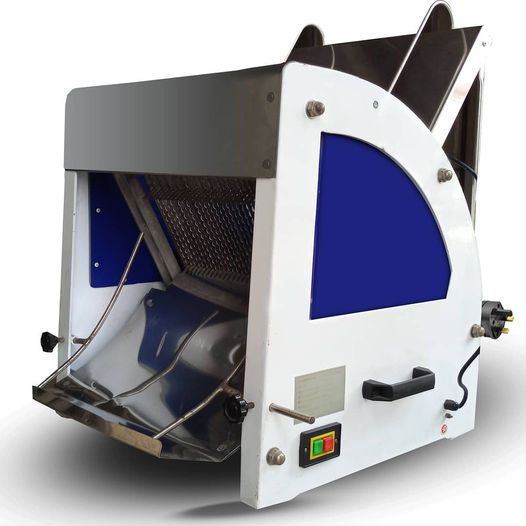
Benefits of a Bread Slicer:
Efficiency: Advantage: Requires less time and effort than manually slicing bread, which boosts the productivity of the bakery as a whole.
Regular Slice Thickness: Advantage: Maintains consistency in slice thickness, which enhances both customer satisfaction and a polished appearance.
Minimizes the chance of broken edges or uneven slices, which minimizes waste and maximizes the usage of each loaf.
Enhanced Production Capability: Advantage: Allows for greater production quantities by simplifying the slicing procedure, which makes it appropriate for industrial bakeries.
Enhanced Safety: Advantage: Lowers the possibility of accidents related to manual slicing, improving worker safety for bakers.
Protection of Product Quality: Advantage: Reduces handling while slicing, maintaining the bread’s freshness and integrity.
Flexibility: Advantage: Adaptable to various bread varieties, ranging from delicate sandwich loaves to artisanal and specialty bread.
Various Bread Slicer Types
Hand-operated bread slicers: These slicers require the operator to guide the loaf through the cutting blades with their hands.
Benefits: Easy to use, appropriate for infrequent slicing requirements or small-scale activities.
Electric Bread Slicer: Enhanced productivity using motorized slicers that incorporate automated feeding systems.
Benefits: Compared to manual slicers, faster and more suited for larger production volumes.
Bread is fed through the slicing blades of a gravity-fed bread slicer by means of gravity.
Benefits: Effective for ongoing slicing; frequently employed in business environments.
Bread is sliced horizontally using this bread slicer, which is ideal for things like baguettes.
Gravity-Fed Bread Slicer:
Description: Uses gravity to feed the bread through the slicing blades.
Advantages: Efficient for continuous slicing, often used in commercial settings.
Horizontal Bread Slicer:
Description: Slices bread horizontally, suitable for items like baguettes.
Advantages: Ideal for specialty or artisanal bread with long and narrow shapes.
Vertical Bread Slicer:
Description: Slices bread vertically, suitable for standard sandwich loaves. Advantages: Versatile and commonly used for a variety of bread types.
Automatic Bread Slicer:
Description: Fully automated slicers with conveyor systems for continuous slicing.
Advantages: High-speed operation, suitable for large-scale industrial bakeries.
Adjustable Thickness Bread Slicer:
Description: Allows users to adjust the thickness of each slice according to preference.
Advantages: Versatility in meeting customer preferences for different slice thicknesses.
When choosing a bread slicer, consider factors such as the bakery’s production volume, the types of bread produced, and the desired level of automation. Each type of bread slicer offers specific advantages, catering to different operational needs in a bakery.
3. Kitchen Safety And Hygiene
Importance of Maintaining a Clean and Safe Baking Environment:
Product Quality:
Importance: Producing baked goods that satisfy customer standards and are of high quality and purity requires a clean atmosphere.
Client satisfaction: significance Keeping things tidy and hygienic helps build consumer confidence and happiness, which promotes repeat business.
Adherence to regulations: significance Respecting safety and hygienic guidelines guarantees adherence to regional health laws, averting legal troubles and fines.
Workplace Health: Relevance: The health and wellbeing of bakery employees are enhanced by a clean atmosphere, which also lowers the possibility of accidents or illness.
Equipment Durability: Relevance: Consistent cleaning and upkeep help baking equipment last longer and require fewer replacements and repairs over time.
Efficiency and Workflow: A bakery that is well-kept and organized has a more efficient workflow, which saves time and effort in the production process.
Cross-contamination prevention: significance Cross-contamination can be avoided by using appropriate cleaning techniques, which guarantee that pollutants or allergies from one batch won’t influence others.
Essential Safety Tools And Procedures
Equipment for personal protection (PPE):
Tools: aprons, hairnets, gloves, and sensible shoes.
Practices: Require PPE use to safeguard bakery workers from potential risks and to uphold hygienic standards.
Equipment: Carefully positioned fire extinguishers around the bakery.
Procedures: Replace and service fire extinguishers on a regular basis. Make sure personnel are instructed on their correct usage.
First Aid Kit: Provisions: Fully stocked first aid kit containing all necessary medical items.ss
Procedures: Provide basic first aid training to employees and make sure a designated first aider.
Equipment for clearly indicated emergency exit signs is provided by emergency exit signage.
Practices: Make sure that all employees are familiar with evacuation protocols by holding frequent drills.
Slip-Resistant Flooring: Mats or flooring that resists slippage are the equipment.
Practices: To avoid falls and slips, keep floors dry and clean. Examine and replace worn mats on a regular basis.
Machine Guards: Equipment: Guards that provide protection for moving parts on equipment.
Procedures: To avoid mishaps and injuries, routinely examine and maintain machine guards.
Instructional Plans:
Equipment: Training aids and instructional materials.
Procedures: Conduct frequent safety training courses to inform employees about possible risks and safe work procedures.
Sanitization products: Tools: disinfectants, sanitizers, and cleaning products.
Practices: Create a cleaning plan, instruct employees on sanitization techniques, and make sure all cleaning supplies are available.
Equipment: Sufficient ventilation systems for managing airborne particulates.
Practices: To guarantee a safe and healthy working environment, clean and maintain ventilation systems on a regular basis.
Labels & Signs for Safety:
Equipment: Safety labels and signage that are easy to see.
Practices: Post safety guidelines for employees and use signage to show potential hazards.
A clean and safe baking environment requires regular training and awareness campaigns, the use of the right tools, and attention to safety procedures. These procedures not only guarantee the health and safety of the bakery workers, but they also enhance the company’s general performance and stand.
CONCLUSION
At Harrymag Ventures Limited, you can get all the equipment with with images attached to them and other industrial machines for laundry, kitchen and catering, gas generators and refrigerations. Our offices are located at Nos 82 Allen Avenue Ikeja Lagos.
